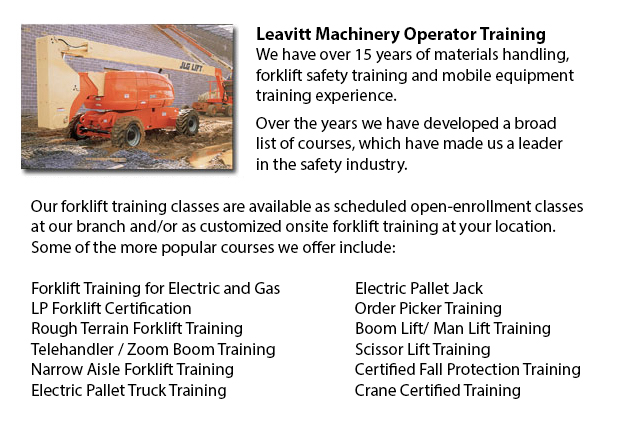
Boom Lift Certification Saskatchewan - Utilizing elevated work platforms allow for maintenance operations and work to be done at elevated work heights which were otherwise not reachable. Boom Lift Certification Training teaches workers regarding safely operating boom lifts and scissor lifts.
When work platforms are operated unsafely, they have the possibility for serious injury and even death, regardless of their lift style, application or the site conditions. Electrocution, falls, crushed body parts, and tip-overs could be the unfortunate outcome of wrong operating procedures.
In order to avoid aerial lift accidents, people need to be qualified in order to train workers in operating the certain type of aerial lift they would be utilizing. Controls should be easily accessible beside or in the platform of boom lifts made use of for carrying workers. Aerial lifts should never be altered without the express permission of other recognized entity or the manufacturer. If you are leasing a lift, make sure that it is correctly maintained. Before using, safety devices and controls should be checked to ensure they are functioning properly.
Operational safety procedures are vital in preventing incidents. Operators must not drive an aerial lift with the lift extended (even if a few are designed to be driven with an extended lift). Always set brakes. Set outriggers, if available. Avoid slopes, but when needed utilize wheel chocks on slopes that do not go beyond the manufacturer's slope limitations. Adhere to manufacturer's weight and load limits. When standing on the boom lift's platform, utilize a safety belt with a two-foot lanyard tied to the boom or basket or a full-body harness. Fall protection is not required for scissor lifts that have guardrails. Never climb or sit on guardrails.
The boom lift certification course provides instruction in the following fields: safety guidelines in order to prevent a tip-over; training and certification; slopes and surface conditions; inspecting the travel path & work area; other guidelines for maintaining stability; stability factors; leverage; weight capacity; testing control functions; pre-operational check; safe operating practices; mounting a vehicle; safe driving procedures; power lines and overhead obstacles; utilizing lanyards and harness; PPE and fall protection; and preventing falls from platforms.
The successful trainee would learn the following: pre-operational inspection procedures; training and authorization procedures; factors affecting the stability of scissor and boom lifts; how to prevent tip-overs; how to utilize the testing control functions; how to utilize PPE and fall prevention strategies.
-
Forklift Ticket Saskatchewan
Forklift Ticket Saskatchewan - Pallet jacks and forklifts are both meant for basically the same purpose; to move supplies from one location of your warehouse to another. This is pretty much where the comparison stops however. With the pallet jack, th... More -
Loader Ticket Saskatchewan
Loader Ticket Saskatchewan - Gehl articulated loaders have been made to suit practically any condition. They provide great traction and optimal maneuverability due to a heavy-duty oscillating joint that offers forty five degree rotating angles left a... More -
Forklift Training Programs Saskatchewan
Forklift Training Programs Saskatchewan - Are you searching for work as a forklift driver? Our regulatory-compliant mobile equipment operator training provides instruction in kinds of forklifts, pre-shift check, fuel kinds and handling of fuels, and... More -
Heavy Equipment Operator Classes Saskatchewan
Heavy Equipment Operator Classes Saskatchewan - A heavy equipment operator is an individual who has received the right training in order to operate a particular kind or piece of machinery. There are lots of ways for the operator to undergo training a... More -
Telehandler Training in Saskatchewan
Telescopic handlers usually known as telehandlers for short, are an extremely popular piece of heavy construction equipment. They are usually utilized in the construction and agricultural trades. These equipments have farthest reaching capacity and a... More -
Narrow Aisle Forklift / Order Picker Training / Electric Pallet Jack / Electric Pallet Truck Training in Saskatchewan
A pallet lift is a piece of equipment dedicated in the transporting of pallets of various dimensions and weights. They can be utilized as an attachment for forklifts, cranes and other types of heavy machinery or be applied on their own. Pallet lifts... More -
Operator Safety Training, Re-Qualification Training, In-House Instructor Training in Saskatchewan
Used in just about all industrial construction sites, warehouse operations or boat yards, the lift truck is a very important component so as to help pick up and transfer supplies. The reach feature of a forklift can help improve the applications whic... More -
Aerial Lift Ticket Saskatchewan
Aerial Lift Ticket Saskatchewan - Boom vehicle are often used by phone, cable and utilities firms as they have extended folded arms which are generally folded over the roofs of business vehicles. On the end of the extension of extendable arms usually... More

Forklift Training Saskatchewan
TOLL FREE: 1-888-254-6157
Saskatoon, Saskatchewan
forklifttrainingsaskatchewan.com
Email Us
About Us



